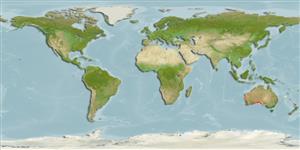>
Perciformes/Scorpaenoidei (Scorpionfishes) >
Pataecidae (Australian prowfishes)
Etymology: Pataecus: Pataeco, a dwarf like Phoenician god. Refers to the likeness of this species to the image of gods on the bows of ancient sailing vessels (Ref. 45335).
More on author: Richardson.
Environment: milieu / climate zone / depth range / distribution range
Ecologia
marinhas demersal; intervalo de profundidade 40 - 80 m (Ref. 9563). Subtropical; 25°S - 36°S
Indo-Pacific: endemic to Australia (Shark Bay, Western Australia (25°21'S) to South Australia and from Moreton Bay, Queensland (27°25'S) to Durras, New South Wales (35°15'S)).
Tamanho / Peso / Idade
Maturity: Lm ? range ? - ? cm
Max length : 27.0 cm TL macho/indeterminado; (Ref. 9563)
Occurs on the continental shelf (Ref. 9563, 75154). Benthic (Ref. 75154).
Ciclo de vida ou comportamento de acasalamento
Maturities | Reprodução | Spawnings | Egg(s) | Fecundities | Larvas
May, J.L. and J.G.H. Maxwell, 1986. Trawl fish from temperate waters of Australia. CSIRO Division of Fisheries Research, Tasmania. 492 p. (Ref. 9563)
Status na Lista Vermelha da UICN (Ref. 130435)
Ameaça para os humanos
Harmless
Uso pelos humanos
Ferramentas
Relatórios especiais
Baixar XML
Fontes da internet
Estimates based on models
Preferred temperature (Ref.
123201): 16.6 - 22.5, mean 17.6 °C (based on 29 cells).
Índice de diversidade filogenética (Ref.
82804): PD
50 = 1.1250 [Uniqueness, from 0.5 = low to 2.0 = high].
Bayesian length-weight: a=0.00389 (0.00180 - 0.00842), b=3.12 (2.94 - 3.30), in cm total length, based on all LWR estimates for this body shape (Ref.
93245).
Nível Trófico (Ref.
69278): 3.7 ±0.4 se; based on size and trophs of closest relatives
Fishing Vulnerability (Ref.
59153): Low vulnerability (17 of 100).
